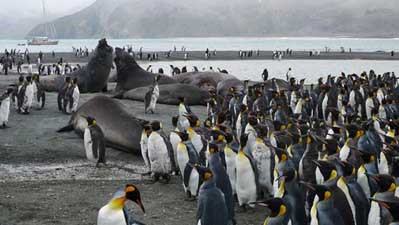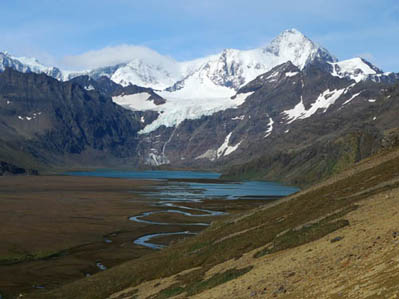One of the most remote of the UK Overseas Territories (UKOTs), South Georgia is a beautiful and rugged island lying 1600 km north of the Antarctic in the South Atlantic Ocean.
 With mountain ranges reaching nearly 3000 m, most of its 3755 km² are covered in permanent snow and glaciers, but at low altitude, within the shelter of its numerous bays, there is a sparse covering of herbaceous vegetation.
South Georgia is known for its spectacular wildlife and as the final resting place of the explorer Sir Ernest Shackleton. It is home to over 50 million seabirds, including globally important populations of wandering albatross and macaroni penguins. During the summer months, the beaches and tussac mounds are overrun by 4.5 million fur seals and 0.5 million elephant seals.
The Government of South Georgia and South Sandwich Islands (SGSSI) manages the island as a pristine wilderness environment with strict bio-security protocols and monitoring of visitors.
With mountain ranges reaching nearly 3000 m, most of its 3755 km² are covered in permanent snow and glaciers, but at low altitude, within the shelter of its numerous bays, there is a sparse covering of herbaceous vegetation.
South Georgia is known for its spectacular wildlife and as the final resting place of the explorer Sir Ernest Shackleton. It is home to over 50 million seabirds, including globally important populations of wandering albatross and macaroni penguins. During the summer months, the beaches and tussac mounds are overrun by 4.5 million fur seals and 0.5 million elephant seals.
The Government of South Georgia and South Sandwich Islands (SGSSI) manages the island as a pristine wilderness environment with strict bio-security protocols and monitoring of visitors.
Plants of South Georgia

South Georgia's flora consists of 25 native species of vascular plants, co-existing with as many introduced species. There are also about 125 species of moss, 85 liverworts and 200 lichens. Woody species are unable to withstand the island's severe weather conditions. The native vegetation resembles that of parts of the Falkland Islands, Tierra del Fuego and southern Patagonia. It is dominated by low herbaceous plants, predominantly in different grassland communities and in mire and bog, mossbank and fellfield. Tussac (Poa flabellata) grasslands are of particular importance as a habitat for native wildlife and introduced species, including reindeer.
South Georgia specimens on the UKOTs Online Herbarium
Herbarium specimens from South Georgia were digitized to form part of the UKOTs Online Herbarium, which was funded by the former Overseas Territories Environment Programme (OTEP) and additional support from the South Georgia Heritage Trust (SGHT). The British Antarctic Survey (BAS) herbarium specimens were also digitised to form part of the UKOTs Online Herbarium, with support from SGHT and BAS.
© Copyright Board of Trustees of the Royal Botanic Gardens, Kew
The Royal Botanic Gardens, Kew's UKOTs team works with the
Government of South Georgia and the South Sandwich Islands (GSGSSI),
South Georgia Heritage Trust (SGHT),
British Antarctic Survey (BAS) and the
Royal Society for the Protection of Birds (RSPB) to protect the native flora and fauna.
Please use the links below to see further details on conservation activities in the UK Overseas Territories.
Anguilla
Ascension Island
Bermuda
British Antarctic Territory
British Indian Ocean Territory
British Virgin Islands
Cayman Islands
Falkland Islands
Gibraltar
Montserrat
Pitcairn Islands
Sovereign Base Areas on Cyprus
St. Helena
Tristan da Cunha
Turks and Caicos Islands
Homepage of the UKOTs Online Herbarium
Homepage of the British Antarctic Survey Online Herbarium
Site published byUK Overseas Territories Team, UK and Islands Programme, Conservation Science Department, Royal Botanic Gardens Kew
Please cite as UKOTs Team (
Current Year). UKOTs Online Herbarium - South Georgia. Facilitated by the Royal Botanic Gardens, Kew. Hamilton, M.A. and Barrios, S. (eds.). Published on the internet at http://brahmsonline.kew.org/southgeorgia (
Date Accessed).
For further information Please contact Kew's
UKOTs Team






